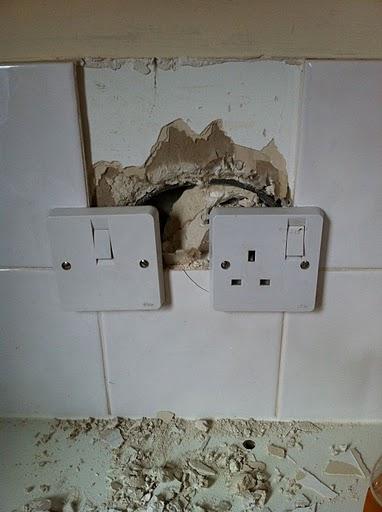Hello,
In my utility room I have a single socket, which is part of the ring main. To the left of this socket, is what looks like a single socket, with no plug holes - just the offset switch (please see the picture, sorry I'm not sure what it's called), this is again part of the ring - fed from the socket then off elsewhere. These two sockets are above a worktop.
Below the work top is a single spur, coming from the socket with the switch and no holes, which powers our washing machine (so we can turn the washing machine off/on without having to pull it out every time I guess - we've similar in the kitchen for the fridge).
We're planning on putting a dishwasher next to the washing machine. Could I check that I'm alright to change the single socket (fed via a single cable) below the worktop to a double socket?
There's no fuse in this socket with the switch, so at the same time would it be worth changing this face plate to a spurred faceplate for added peace of mind?
Here's a picture to clarify what I mean:
What is the correct name for the switched socket with no plug holes in too please, would be good to know as I can't seem to find out what it is searching around... I've not seen light switches, with the switch near the top of the socket, only in the middle.. so am assuming it's something slightly different?
Thank you!
In my utility room I have a single socket, which is part of the ring main. To the left of this socket, is what looks like a single socket, with no plug holes - just the offset switch (please see the picture, sorry I'm not sure what it's called), this is again part of the ring - fed from the socket then off elsewhere. These two sockets are above a worktop.
Below the work top is a single spur, coming from the socket with the switch and no holes, which powers our washing machine (so we can turn the washing machine off/on without having to pull it out every time I guess - we've similar in the kitchen for the fridge).
We're planning on putting a dishwasher next to the washing machine. Could I check that I'm alright to change the single socket (fed via a single cable) below the worktop to a double socket?
There's no fuse in this socket with the switch, so at the same time would it be worth changing this face plate to a spurred faceplate for added peace of mind?
Here's a picture to clarify what I mean:
What is the correct name for the switched socket with no plug holes in too please, would be good to know as I can't seem to find out what it is searching around... I've not seen light switches, with the switch near the top of the socket, only in the middle.. so am assuming it's something slightly different?
Thank you!



